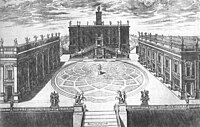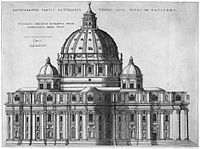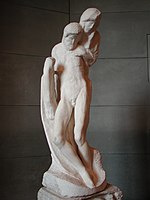Michelangelo di Lodovico Buonarroti Simoni (Italian: [mikeˈlandÊ’elo di lodoˈviËko ËŒbwÉ”narˈrÉ”Ëti siˈmoËni]; 6 March 1475 – 18 February 1564) was an Italian sculptor, painter, architect, and poet of the High Renaissance who exerted an unparalleled influence on the development of Western art. Considered to be the greatest living artist during his lifetime, he has since been described as one of the greatest artists of all time. Despite making few forays beyond the arts, his versatility in the disciplines he took up was of such a high order that he is often considered a contender for the title of the archetypal Renaissance man, along with his rival and fellow Florentine Medici client, Leonardo da Vinci.
A number of Michelangelo's works of painting, sculpture, and architecture rank among the most famous in existence. His output in every field of interest was prodigious; given the sheer volume of surviving correspondence, sketches, and reminiscences taken into account, he is the best-documented artist of the 16th century.
He sculpted two of his best-known works, the Pietà and David, before the age of thirty. Despite holding a low opinion of painting, Michelangelo also created two of the most influential frescoes in the history of Western art: the scenes from Genesis on the ceiling of the Sistine Chapel in Rome, and The Last Judgment on its altar wall. As an architect, Michelangelo pioneered the Mannerist style at the Laurentian Library. At the age of 74, he succeeded Antonio da Sangallo the Younger as the architect of St. Peter's Basilica. Michelangelo transformed the plan so that the western end was finished to his design, as was the dome, with some modification, after his death.
— (Michael Sullivan, translation)
— (Michael Sullivan, translation)
a. ^ Michelangelo's father marks the date as 6 March 1474 in the Florentine manner ab Incarnatione. However, in the Roman manner, ab Nativitate, it is 1475.
b. ^ Sources disagree as to how old Michelangelo was when he departed for school. De Tolnay writes that it was at ten years old while Sedgwick notes in her translation of Condivi that Michelangelo was seven.
c. ^ The Strozzi family acquired the sculpture Hercules. Filippo Strozzi sold it to Francis I in 1529. In 1594, Henry IV installed it in the Jardin d'Estang at Fontainebleau where it disappeared in 1713 when the Jardin d'Estange was destroyed.
d. ^ Vasari makes no mention of this episode and Paolo Giovio's Life of Michelangelo indicates that Michelangelo tried to pass the statue off as an antique himself.
-

Angel by Michelangelo, early work (1494–95)
-

Bacchus by Michelangelo, early work (1496–97)
-

Dying slave, Louvre (1513)
-

Bound slave, known as Atlas (1530–34)
-

The vestibule of the Laurentian Library has Mannerist features which challenge the Classical order of Brunelleschi's adjacent church.
-

Michelangelo's redesign of the ancient Capitoline Hill included a complex spiralling pavement with a star at its centre.
-

Michelangelo's design for St Peter's is both massive and contained, with the corners between the apsidal arms of the Greek Cross filled by square projections.
-

The exterior is surrounded by a giant order of pilasters supporting a continuous cornice. Four small cupolas cluster around the dome.
-

Statue of Victory (1534), Palazzo Vecchio, Florence
-

The Pietà of Vittoria Colonna (c. 1540)
-

Michelangelo and Tiberio Calcagni, Pietà Firenze (c. 1550–61)
-

The Rondanini Pietà (1552–64)
- Ackerman, James (1986). The Architecture of Michelangelo. University of Chicago Press. ISBN .
- Clément, Charles (1892). Michelangelo. Harvard University, Digitized 25 June 2007: S. Low, Marston, Searle, & Rivington, ltd.: London.
- Condivi, Ascanio; Alice Sedgewick (1553). The Life of Michelangelo. Pennsylvania State University Press. ISBN .
- Baldini, Umberto; Liberto Perugi (1982). The Sculpture of Michelangelo. Rizzoli. ISBN .
- Barenboim, Peter and Shiyan, Sergey (2011). Michelangelo in the Medici Chapel: Genius in details (English, Russian). Moscow: Looom.
- Bartz, Gabriele; Eberhard König (1998). Michelangelo. Könemann. ISBN .
- Einem, Herbert von (1973). Michelangelo. Trans. Ronald Taylor. London: Methuen.
- Gardner, Helen; Fred S. Kleiner, Christin J. Mamiya, Gardner's Art through the Ages. Thomson Wadsworth, (2004) .
- Gilbert, Creighton (1994). Michelangelo On and Off the Sistine Ceiling. New York: George Braziller.
- Goldscheider, Ludwig (1953). Michelangelo: Paintings, Sculptures, Architecture. Phaidon.
- Goldscheider, Ludwig (1953). Michelangelo: Drawings. Phaidon.
- Hartt, Frederick (1987). David by the Hand of Michelangelo—the Original Model Discovered, Abbeville,
- Hibbard, Howard (1974). Michelangelo. New York: Harper & Row.
- Hirst, Michael and Jill Dunkerton. (1994) The Young Michelangelo: The Artist in Rome 1496–1501. London: National Gallery Publications,
- Liebert, Robert (1983). Michelangelo: A Psychoanalytic Study of his Life and Images. New Haven and London: Yale University Press. ISBN .
- Néret, Gilles (2000). Michelangelo. Taschen. ISBN .
- Paoletti, John T. and Radke, Gary M., (2005) Art in Renaissance Italy, Laurence King,
- Pietrangeli, Carlo, et al. (1994). The Sistine Chapel: A Glorious Restoration. New York: Harry N. Abrams
- Sala, Charles (1996). Michelangelo: Sculptor, Painter, Architect. Editions Pierre Terrail. ISBN .
- Saslow, James M. (1991). The Poetry of Michelangelo: An Annotated Translation. New Haven and London: Yale University Press.
- Rolland, Romain (2009). Michelangelo. BiblioLife. ISBN .
- Seymour, Charles, Jr. (1972). Michelangelo: The Sistine Chapel Ceiling. New York: W. W. Norton.
- Stone, Irving (1987). The Agony and the Ecstasy. Signet. ISBN .
- Summers, David (1981). Michelangelo and the Language of Art. Princeton University Press.
- Tolnay, Charles (1947). The Youth of Michelangelo. Princeton, NJ: Princeton University Press.
- Tolnay, Charles de. (1964). The Art and Thought of Michelangelo. 5 vols. New York: Pantheon Books.
- Wallace, William E. (2011). Michelangelo: The Artist, the Man and his Times. Cambridge University Press. ISBN .
- Wilde, Johannes (1978). Michelangelo: Six Lectures. Oxford: Clarendon Press.
...
Wikipedia